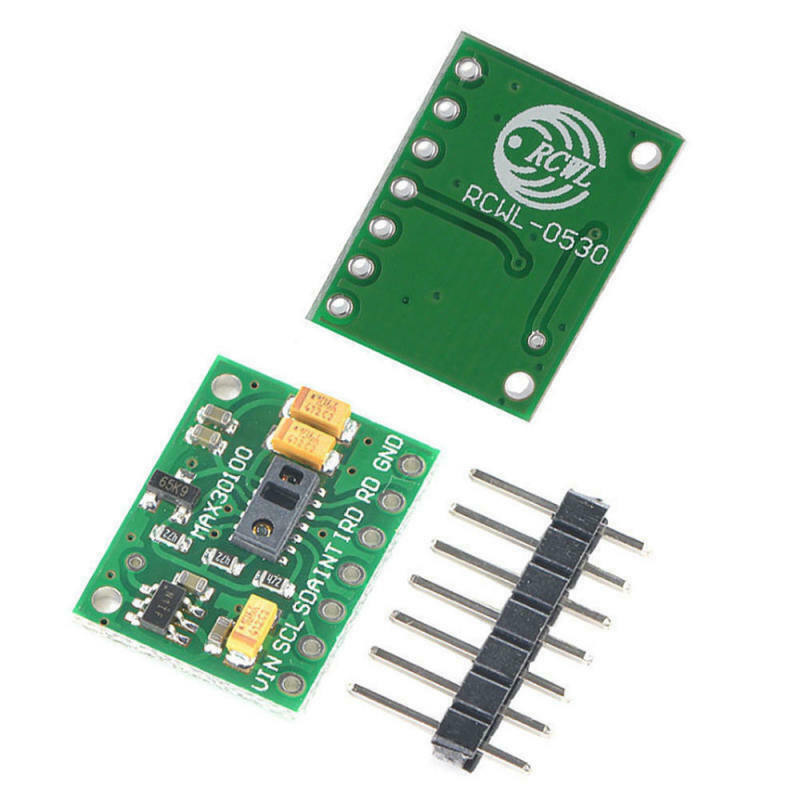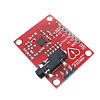
Ship to all EU countries
Art: NB110EAN: 8720828223055
MAX30100 Pulse Oximeter Heart Rate Sensor Module (OT3616)
Show all:
Sensors,Heart Rate Sensors
Would you like to order large quantities of this product or do you need a quote to order within your organization? Then request a quote.
REQUEST QUOTEThank you for your request.
You will receive the quote in your mailbox within a few minutes.
You will receive the quote in your mailbox within a few minutes.
Ship to all EU countries
30 days cooling-off period
1 jaar garantie
Description
MAX30100 is a sensor solution for SpO2 and heart rate measurement. It combines two LEDs, a photodetector, optimized optics and low-noise analog signal processing to detect pulse oximetry and heart rate signals. You can use this sensor with any microcontroller such as Arduino, ESP8266 or ESP32 and easily measure patient's health parameters. This low-cost DIY pulse oximeter sensor can be used in multiple applications if you are a beginner or an electronics enthusiast. MAX30100 sensor can measure blood oxygen and heart rate. We can use any display such as 16x2 LCD to view the value of SpO2 and BPM. The oxygen concentration in the blood, called SpO2, is measured in percentage and the heart rate/pulse rate is measured in BPM.size: 30*20mm More about this moduleBfeatures an advanced oximeter and heart rate sensor, which works based on two integrated LEDs, a photosensitive element and a highly accurate and advanced analog front with low noise, for clean and accurate measurements. By placing for example an index finger on the top of the sensor, you can get both the heart rate and the blood oxygen saturation via the I2C interface. Features such as Ambient Light Cancellation (ALC) and discrete time filters, ensure that no ambient light or 50/60Hz disturbs the measurements. One of the most important features of this device is its low power consumption: it is possible to put the device in Standby mode, where it has a very low power consumption. All in all, this module is an ideal solution for various heart rate and SpO2 related applications, as well as the development of new algorithms for reading blood parameters based on the red and infrared absorption properties of the human body, mainly for arterial blood oxygen saturation (SpO2) and heart rate (HR). How does SpO2 measurement work based on IR and Red LED light with this MAX30100 sensorThe measurement of hemoglobin oxygen saturation (HbO2) by measuring the absorption of the red and IR light of the pulsating components was introduced in 1935 by Karl Matthes, a German physician. In the beginning, there were no good photodetectors and instead the IR band, the green band of the light spectrum, was used. As technology progressed, more reliable methods of light detection were developed and the green light was replaced by the IR light. Today, advanced algorithms allow separation between the signals of the pulsating arterial blood and moving venous blood, allowing for more accurate and reliable measurements. The sensor on this module, MAX30100 is a modern integrated pulse oximeter and heart rate sensor IC. This sensor has two integrated LEDs with the RED and IR LEDs, which are used to emit the respective wavelengths. The wavelengths of these LEDs are 660nm and 880nm respectively. The reflected light is detected by a red/IR photodetector element and sampled by a low noise delta-sigma 16-bit ADC. The analog front end of the MAX30100 sensor is equipped with an Ambient Light Cancellation (ALC) section, which eliminates light contamination from the photodetector element. The 16-bit ADC is filtered by a discrete time filter to prevent 50/60Hz interference and hum. The output sampling rate can be adjusted from 50Hz to 1kHz. There is also a temperature sensor, which can be used to compensate for environmental changes and calibrate the measurements. The MAX30100 sensor has the FIFO buffer, 16 words deep. The FIFO buffer stores the measured values and can generate an interrupt when the buffer is full, allowing the host MCU to perform other tasks while the data is being collected by the sensor. The integrated LED drivers are controlled with pulses of selectable width: pulses can range from 200 µs to 1600 µs. The width of the pulse affects the available ADC bit depth and sampling rate. The pulse width of 1600 µs allows a maximum resolution of 16 bits with the highest sampling rate of 1 ksps, while the pulse width of 200 µs only allows 100 sps for a resolution of 16 bits. By reducing the resolution to 13 bits, the full sampling rate of 1 ksps is possible. Control of the LED pulse width, together with the programmable LED current, optimizes the measurement accuracy and power consumption. The power for the LEDs comes directly from the 3.3V rail of the mikroBUS™. In order to improve the measurements, the MAX30100 sensor uses a temperature sensor. This is a fairly accurate temperature sensor, which measures the mold temperature with an accuracy of ±1C in the range of -40C to +85C. This sensor can be read out from its data register and can optionally be used to compensate the sensor measurements for fluctuations in the ambient temperature. However, there are several other external factors that can influence the accuracy of the device: In addition to the temperature, the measurements can also be negatively influenced by excessive movement. Also, too much pressure can constrict the capillary blood flow and thus reduce the reliability of the data. These problems arise from the nature of the measurement method and must be considered when developing your own application. The MAX30100 sensor is supplied by the small LDO, which provides a clean and ripple-free 1.8V for the internal logic and photodetector element of the sensor. The input voltage also comes from the 3.3V power rail of the mikroBUS™. In addition to the I2C lines of the sensor IC, which are routed to the respective mikroBUS™ SCL and SDA lines, the interrupt line of the sensor is also routed to the mikroBUS™ INT pin. By setting the appropriate INT register, the interrupt can be generated and enabled for 5 different sources: power ready, SpO2 ready, HR ready, temp ready, FIFO full. The power ready interrupt is enabled by default and cannot be disabled in software, but all other interrupts can be disabled or enabled.
Reviews
0/10
No reviews found
Add your review























